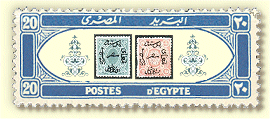

The first issue of Egypt had a rather long gestation period, which began on 7 June 1864 when Giacomo Muzzi, Director of the Posta Europea, requested permission from Ismail Pasha, the Viceroy, to issue postage stamps. The proposal was overtaken by the purchase of the Posta Europea by the Egyptian Government, consummated in January 1865. Muzzi Bey, who was retained as Postmaster General, was directed to proceed with dispatch to have stamps prepared and in April 1865 he was given authorization to arrange for the printing abroad. Offers, in some cases accompanied by essays, had already been received from several firms, among them Pellas Brothers of Genoa, the firm ultimately selected. The correspondence relative to these events is preserved in the Postal Museum in Cairo; the more important documents have been published in full in the original Italian and in English translation by Ibrahim Chaftar Bey1. A description of the essays for this issue, including colors recorded and general information, has been published by Byam2. Some essays by Negroni and by Prevost have survived (Fig. 1). The similarity of the designs to the issued stamps and to the model sketch (Fig. 2) prepared by the Egyptian Government suggests that they were solicited, directly or indirectly. The Negroni essay was printed on glazed card. Moëns3 lists nine color combinations (background stamp and overprint). There was only a single denomination, 10 paras, and the overprints were all of 1 piaster (bir ghroush). These essays are very rare; none was in the Byam collection. Three were in the sale of the Palace Collections, but were not explicitly noted in the catalog. The Negroni essay was imitated at a very early date (one might even say it was forged). The Prevost imitations differ from the Negroni essays in many qualitative aspects which are easily apparent when the two are compared side-by-side. A simple quantitative difference occurs in the concentric circles on which the stars are drawn. On the Negronis there are three thin circles between two thick ones, whereas the Prevost essays have four thin circles between two thick ones. Furthermore, the pearls are all properly aligned in the Negroni essays, but one pearl is displaced noticeably inwards in the Prevost design (between 8 and 9 o'clock, or 2 and 3 o'clock, depending on viewing orientation. Moëns, writing in 1881, stated that the imitations were commissioned by Commander Antonio de Tedesco who had them printed by Prevost of Paris. However, one should recognize the possibility that the imitations were not made for sale to collectors, but to demonstrate to the Egyptian Government the virtuosity and capabilities of the Prevost firm without having to go to the trouble of creating a new design. An example of a Prevost essay imprinted on an envelope exists actually used in Egypt in 1869 addressed to France (the essay had no franking power, of course, and the cover was treated as stampless)4. This shows that the Prevost essays were at least close to contemporary with the First Issue, and that they actually reached Egypt. 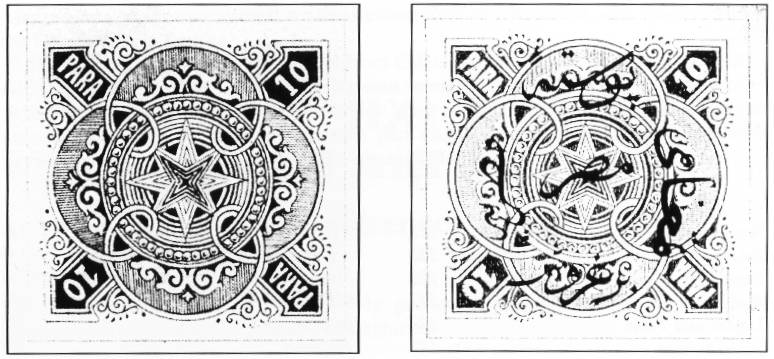 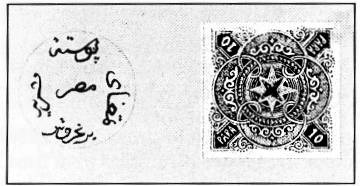 Fig. 1 Essays by Negroni (above right) and by Prevost  Fig 2. Sketch from Egypt. They were prepared in a variety of colors, on ordinary paper, white or tinted, on thin, glazed card, and on envelopes. All were denominated 10 paras. Some of them were printed without an overprinted inscription and value, which were printed next to the basic design, with a denomination of 1 plaster, inside a thin circle in the same color. These essays are often found without the adjacent overprint, but it cannot usually be said whether they were so printed or were cut apart afterwards. The Prevost essays also exist with the overprint directly on the stamp in black or other colors. With these, the overprinted denomination is either 20 paras or 1 piaster. The essays by Pellas Brothers also had designs extremely close to the issued ones (Fig. 3). They were lithographed. They included a 20pa. blue, 2pi. blue, 5pi. blue, 5pi. red, 10pi. blue, and 10pi. yellow, all on unwatermarked paper, imperforate, as well as a 10pa. yellow (perf. 13), a 10pa. lilac, a 1pi. lilac with overprint of the 10pa., and a 2pi. yellow-orange with overprint of the 20pa., these four being on the watermarked paper as issued. The Pellas essays are very rare, and some may be one of a kind, but multiples of the Pellas 1pi. overprinted 10 paras exist. The Prevost ones are not so difficult to find and they were evidently printed in a moderate quantity, but the combinations of colors, papers, and surcharge colors led to a very large variety of them. Any specific combination can fairly be labeled rare (I cannot recall ever having seen two alike). The Egyptian Government prescribed paper watermarked with a pyramid surmounted by a rayed sun (some call it a star). The required paper was ordered by Pellas Bros. from the firm of Bondi, of Turin. It was to be the cause of much trouble to Pellas Bros. 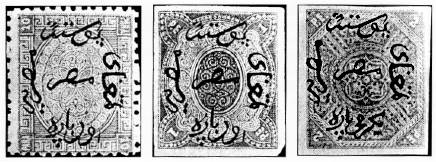 Printing The correspondence describes the printers' unhappy experience with the paper. The supply was improperly sized, so that it absorbed the gum (applied after printing). This stained and disfigured the stamps so badly that they were unacceptable. The printers therefore did their best to deal with a bad situation and dipped the printed sheets (and presumably the paper not yet used) in an alum solution to harden and size the paper. Although this measure solved the gum problem, it created a new one, so Pellas Bros. claimed, by shrinking the paper to a variable degree. Consequently, they claimed, it was difficult to perforate the sheets with the desired precision. However, that claim is not entirely credible, for the 1pi. stamps, printed on unwatermarked paper not requiring the alum treatment, seem to be no more accurately perforated than the values on watermarked paper, and the dimensions of the printed stamps do not vary. The alum treatment was evidently undertaken before all the stamps had been printed. Much spoilage occurred, depleting the stock of watermarked paper so that there was not enough left to complete the order. To meet this problem the printers resorted to plain, unwatermarked paper for the 1pi. value. This smooth paper produced a clearer image than the watermarked paper, which had a rough, fibrous surface. Despite the difficulties, the order was completed in time for dispatch to Egypt on 30 September 1865. The quantities invoiced are shown in the table. The very small consumption of the 5 and 10pi. stamps is notable, and is consistent with the scarcity of used copies of these stamps. The large remainders of the 2, 5, and 10pi. pose the question of their fate. The 5 and 10pi. are admittedly easier to find unused than used, but their overall scarcity is so great as to be inconsistent with the possibility of the remainders having been sold to the philatelic market5 (only two unused blocks of the 5pi. and one of the 10pi. are known). Presumably, therefore, the remainders were destroyed, although one cannot rule out the possibility that a few were pilfered before destruction. QUANTITIES OF THE FIRST ISSUE
Proofs A presumed die proof of the 10pi. (i.e., a pull from an original lithographic stone or drawing) is known in grey-black without the overprint. Examples of the 1pi. in black without overprint, originating from a sheet, are also known. Plate proofs on watermarked paper, without overprint and imperforate, are known for the 2 and 10pi. in the issued colors (with the 10pi., the shades are different). It is, however, not easy to tell which are proofs and which may be printer's waste, for all such residual material is said to have been sent to Egypt accompanying the ordered stamps. No proofs of the overprints are known, although purported examples have been offered (they are merely proofs of the 5pi. from which most, but not all, traces of the rose background design have been removed). Proofs of all values in the issued colors, on smooth, unwatermarked paper, without gum, mostly imperforate, are plentiful, and complete sheets have survived, as well as numerous pairs, strips, and blocks. I have seen examples with gum, and it is reasonable that Pellas Bros. would have made some gumming trials, but I cannot say whether the gummed examples may not be the result of philatelic inspiration long after the time of the issue. It is these proof sheets that made possible the comprehensive studies by Dr Byam6 of the printing procedures. They also enable single stamps to be plated to their original positions in the sheet. The quantity of these proofs raises the question of whether their preparation actually preceded the printing of the issued stamps or whether they were an afterthought, or even a kind of reprint. The 1-plaster denomination provides the evidence that they were, indeed, true proofs, printed ahead of the quantity of stamps contracted for. The typographed basic stamp had a complex design and the plate was subject to wear and clogging by accumulated ink crusts. These factors led to a loss of detail as the printing of the contract order proceeded; some of the smaller white areas became filled in, giving a blotted appearance. The proofs, however, show all the fine detail, without any blotting, and it is clear that they were printed from a pristine plate, and therefore before the main order. Perhaps they were made to test the substitute paper eventually used for the 1pi., although there is evidence that the proof paper is of a slightly thicker stock7 (see below under Perforation). Less commonly, the unwatermarked proofs are found perforated variously 11˝, 12˝, 13, 13˝, combinations of these gauges, and 12˝ x15. These are presumably perforation trials, although perforations have also been forged in order to pass off the cheaper proofs as the issued stamps. A complete sheet of the 1pi. perf. 13 throughout was offered in a Feldman auction in 1995. Layout and Types The layout of the proof sheets is generally assumed to be the same as the issued stamps although there are some discrepancies that imply either two stones or substituted transfers. To understand it, the designs of the stamps have first to be considered. The superficial impression is of designs having a two-fold axis of symmetry (if the designs are rotated 180 degrees in the plane of the paper they appear the same). The designs are in fact without any symmetry, and rotation by 180 degrees produces a detectable difference. Consequently, when the basic stamps were overprinted, two types resulted according to the orientation of the overprint to the background. These have traditionally been called Types I and II (assigned arbitrarily). The two types for each value are identified in Figure 4. The designs were probably intended to be symmetrical and the small deviations are presumably the result of drawing the designs by hand. If the printers noticed the differences, they evidently considered them to be of no account and the individual subjects were assembled in the stones and plate haphazardly. Consequently, every sheet was a mixture of Types I and II, which in many positions were tęte-bęche to each other. Furthermore, in the overprinting step, there was no concern about orienting the sheets in a particular direction and Types I and II appear to be equally common for all values and are of little philatelic significance. Dr Byam has described6 the rationale by which he assigned `upright' and `inverted' to the designs of the six lithographed backgrounds. He took the upper right corner subject of the sheet as the key on the assumption that the Italian printers would have built up the stones starting from the left side (which would have printed the right side of the sheets). Byam originally studied the 20pa. proof sheet and subsequently found that his conclusions derived from it applied as well to the other lithographed values. The process he deduced was that a single die was impressed ten times on a strip of lithographic transfer paper to make a vertical column. The transfer paper was then laid down on a matrix stone. Very small flaws were introduced at each impression, such that each of the ten can be individually recognized. These flaws recur across the sheet, in principle twenty times (except for some substitutions). These he considered to be the primary types (the designs were oriented more or less randomly, `upright' or `inverted', on the matrix stone). Twenty impressions were taken from the matrix stone and these were laid down side-by-side on the printing stone to make a sheet of 200 subjects, 20 x 10. This was done on the para values without regard to what might be the `top' or `bottom' of each strip; but with the 2, 5, and 10pi., the strips of ten were all the same way up. Some minute secondary flaws were introduced during this stage, but these do not recur. As a result of this procedure each design has ten primary types (except the 10pi., see below); they are numbered with arabic numerals to avoid confusion with the old Types I and II. Byam illustrated them with drawings for the 5, 10, and 20pa. and the 10pi. (Figs. 5 to 8). The types of the 2 and 5pi. have been described but not yet illustrated8 (Figs. 9 and 10). It is possible to assemble a collection of each of the types, but it is a very difficult task. Apart from the scarcity and cost of 5 and 10pi. stamps, there is also the vexation of identifying the characteristic flaws, which are often obscured by cancellations or punched out by perforations (it is easier to work with proofs). The yellow 2pi. is especially difficult to work with because the eye does not distinguish details in that color readily. For this value it is advisable to resort to black-and-white photographs, as the photographic film is more sensitive to yellow and converts the image into a more easily examined form. The layout of the types is shown in Figures. 11 to 14. The 10pi. is a special case because there are only nine types. What would have been Type 10, across the bottom row of the sheet, is replaced by Types 1 to 9, more or less in order from left to right (Fig. 14). Probably there was a defect in Type 10 on the matrix stone and the transfers from it were discarded. From the layouts it can be seen that there were also other cases of substitution of individual transfers, thereby interrupting the order of types.
2 PIASTRES 1 Small break in central loop of chain on left. 2 Small break in left upper white central circle just to right of uppermost point. 3 Small break in outer side of lower left white triangle level with foot of "2". 4 Small coloured projection outside lower frame line opposite left angle of triangle in right lower corner. Break as on Type 6. 5 Small coloured dot outside upper border to left of right upper angle of hexagonal chain frame. 6 Marked break in left outer coloured frame line level with lower portion of "P". 7 Small break in upper white frame line to right of stop after "E" in left upper corner. 8 Small break in upper white frame line at inner angle of triangle in right upper corner. 9 Small break in lower outer coloured frame line with fragment turned outwards to the left. 10 Fifth pearl from the top in the lower of the two left upper diagonal columns is broken and appears white to left. 5 PIASTRES 1 Loop of band touches N.E. circle. Flag of "5" in N.E. corner indented above. Lower white frame line broken I mm. to left of S.E. circle. 2 Coloured flaw in circle round "P.E." in S.E. corner. Break in right outer frame line three-quarters of the way down. 3 N.W. ray of central rosette fails to reach the centre. Break in outer border of S.E. loop of band at extreme right. 4 Minute coloured flaw on looped band just above S.W. loop. 5 Broken "5" in S.W. corner. 6 White flaw in background between lower frame line and curved white line above it, to left of mid-line. 7 Design inverted: Space between loop and N.E. circle. Break in outer frame line just below junction with circle in N.E. corner. 8 White break in outer coloured margin of circle in S.E. corner. 9 Circular coloured flaw in white circle at N.W. corner below "P.E.". 10 Design inverted: Coloured flaw projecting upwards into upper transverse portion of looped band to left of mid-line. The overprint stones for the 5, 10, and 20pa., and the 5 and 10pi. were made up similarly, with the difference that the matrix stones consisted of vertical strips of five rather than ten. Two impressions from the matrix stones were laid down one above the other to make an intermediate stone from which twenty transfers were taken to make the printing stone. Since flaws were introduced in these steps, there are five primary types for each overprint, each of which exists in two minor variants which recur across the sheets. The types of the 20pa. are shown in Figure 15. The overprinting stones and plates had another feature: marginal inscriptions. These were in large serifed capitals (smaller on the 1 pi.) reading across the top of the sheet VICE REALI POSTE EGIZIANE, across the bottom, MINISTERO DEI LAVORI PUBBLICI, and on each side, FRANCOBOLLI and the denomination (Fig. 22). Only a few pieces of the issued stamps have survived with parts of these marginal inscriptions attached, but they are less rare in the proofs. Bearing in mind that the overprints were not necessarily applied uniformly in `upright' or in `inverted' orientation, we can conclude that a given primary type of overprint might be found on at least four different types of the background stamp. For example, consider a column of ten of the basic stamp, consisting of Types 1 through 10, and a column of ten of the overprint, consisting of Types 1 to 5 and again 1 to 5. Type 1 overprint would fall on Types 1 and 6 of the background. If the sheet had been turned before overprinting, Type 1 overprint would fall on Types 10 and 5 of the background. Additional possibilities might arise where a substituted transfer occurs. Such combinations can, of course, be collected, but an exhibit of them would be unlikely to engage the enthusiasm of any but the hard-core devotee. The significance of these types and combinations of them is primarily in protection against forgeries. For potential reference, not only do complete proof sheets exist in some private collections, but photographs of them, in normal size or enlarged, are in the hands of other collectors and expert services.
The foregoing discussion of the lithographic types does not, of course, apply to the typographed impressions. The overprints of the 1 and 2pi. and the basic design of the former have been studied with great care. There seem to be no flaws that recur within the sheets, and thus no recognizable types. This situation implies that there was a single die for each, which was replicated 200 times, presumably by stereotyping. Many flaws, some of them quite prominent, resulted. They consist mostly of broken or distorted lettering or framelines. Their plate positions can be determined from the proof sheets and they are constant. Many of them have been described and illustrated9,10. Some examples of the 2pi. have an overprint that has a quite distinctive thin appearance, with many small skips in the inking (Fig. 16). 1 have seen them only unused, either imperforate or pert. 12˝ x 15. Some have been plated, and they were clearly printed from the same stone and plate as the other 2pi. stamps. They may be from a trial printing of the overprint in which the make-ready blanket was too hard, resulting in poor contact. 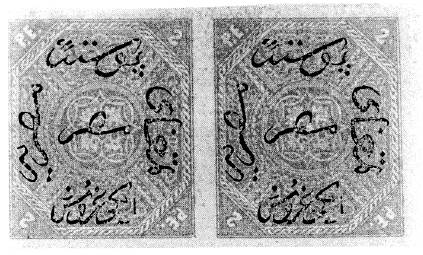 Fig. 16 "Thin" overprint on the 2pi. The plate for the 1pi. was laid out differently from the other values. It consisted of two panes of 100 separated by a vertical gutter of about half the width of a stamp. The gutters were framed by two rows of vertical perforation, and wing margins are therefore not known. Some pieces exist with gutter attached but separated by a row of perforation. No example of a horizontal pair of the issued stamp with gutter between is known, although they may exist. Gutter pairs and blocks of the proofs are known, however. Issued stamps The stamps were received in Egypt in adequate time to distribute them to all post offices. A long decrees11, Rules for the Internal Postal Service, was issued on December 21st 1865 to come into effect on January 1st. The following section excerpted from it announced the impending stamp issue.
The stamps went on sale as promised, and there is no evidence of any prior sale. The colors were:
These colors are not as bright as those of the proofs (except for the 1pi.); the very different nature of the paper surface may be the cause. Watermark The issued stamps are further complicated by the watermark and perforation. The watermark design (Fig. 17) has no symmetry whatever, and consequently it can have four orientations: upright, with the leading edge of the pyramid to the left or to the right, and inverted, leading edge left or right. All of these exist on each value (except, of course, the lpi.), but not by any means in the same quantities. Upright watermarks (with respect to the overprint) are surprisingly scarce on the 5pa. and the 2pi., but the 20pa. is scarcer with inverted watermark. The 5pa. with upright watermark is in fact a rarity. Comparison of known examples shows that at least two sheets must have originally been printed, however, to account for differences in the centering of the watermark with respect to the background design. Some left-over watermarked paper eventually found its way into philatelic hands and part of it was used in making the Salama forgeries (see below). It should be noted that the sun has ten rays (some positions have one weak or partial ray). The illustrations in the Scott and Gibbons catalogs, as well as the several editions of Zeheri, are in error, and were apparently made from forgeries.  Fig. 17 Watermark: sketch from Egypt, and actual. Perforation The perforations add a complication of their own. Most stamps are perf. 12˝, but some have one, two, three, or even four sides perf. 13. Because it is possible to determine plate positions even of single stamps, it has been found that the stamps of perf. 13 on four sides are overwhelmingly corner stamps. For the most part, those stamps perf. 12˝ x 13 are from either the leftmost or rightmost columns, and those perf. 13x12˝ are from either the top or bottom row. It would appear that the machine that produced the 12˝-gauge lines had some sort of mechanical limitation that prevented it from being used to perforate the last two lines in each sequence of operation. Another machine, gauging 13, was presumably used to supply the missing four rows. The pattern that would result is shown in Fig. 18 for one of the four possible orientations. The practical effect was to produce from each sheet of 200: one stamp perf. 13, two stamps perf. 13 on three sides, one stamp pert. 13 on two adjacent sides, 18 stamps perf. 13x12˝, 8 stamps perf. 12˝ x 13, 8 stamps perf. 13 on one or the other side, and 18 stamps perf. 13 at either top or bottom12. The perforators were capable of doing only one line at a time, and it was thus easy for a row to be omitted inadvertently. Apparently, when such an omission was noticed it was rectified by use of the gauge-13 machine. As a consequence, one or more edges of some stamps were perforated 13 in sheet positions other than the usual pattern. Stamps perf. 13 on all sides are the most eagerly sought. All values are known in this condition, but it is obvious that they are rare. One should be wary of forgeries, but more wary of mis-measurement. The difference between perf. 121/2 and 13 is not large, and a surprisingly high proportion of collectors and dealers (including auction describers) seem to be incapable of using a perforation gauge reliably. It is essential to make a careful check of any perforation rarity that may be offered, beginning with a check of the accuracy of the perforation gauge that one intends to use by counting the number of perforations in 20mm.
The 1pi. imperforate presents another problem: how to distinguish it from the imperforate proofs. There are two ways to approach the task. One has already been described with respect to distinguishing perforated proofs from the issued stamp: the loss of some detail of the design as the printing proceeded. The other is use of a thickness gauge7. The proofs are generally on thinner paper than the issued stamps; most proofs have a thickness less than 0.0027 inch (0.067mm), and nearly all issued stamps are 0.0030 inch (0.075mm) thick or thicker. Only a very few stamps fall into the intervening range (the result of unevenness in the sheets of paper), and most of them can be identified by means of the first criterion, sharpness of impression. Double perforations are not rare, nor are severely misplaced perforations, which sometimes run through the middle of the stamps. In such extreme cases the stamps were usually separated from the sheet by use of a knife or scissors as though they had been imperforate. These are, of course, in no way double perforations, but such stamps are often improperly described as "imperforate, with an extra row of perforations across the stamp". One other perforation variant must be mentioned: 12˝ x 15. This is the gauge of the Second Issue (necessarily turned 180 degrees), and it is hypothesized that some imperforate or partly imperforate sheets delivered to Egypt may have been used for perforation trials for the succeeding issue. This gauge is known on the 10pa., 2pi., and the error stamp, 5pi. with overprint of the 10pi. They might be considered to be proofs except for the fact that at least one example of the last stamp is known with an apparently genuine cancellation. These varieties are rare, the 10pa. being the most so. One copy of the 2pi. is known with perf. 15 on three sides. 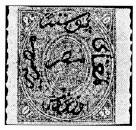 As an anomaly, the 10pi. exists partly rouletted. This is a very rare variety (I have record of only two examples) and its origin is not known. One can only speculate that it represents an attempt to deal with defectively perforated sheets, officially or privately.
As an anomaly, the 10pi. exists partly rouletted. This is a very rare variety (I have record of only two examples) and its origin is not known. One can only speculate that it represents an attempt to deal with defectively perforated sheets, officially or privately.Fig. 19 The 10pi. rouletted. Retouches Before proceeding, it is necessary to comment on the problem of designating positions in the sheets. The problem exists only for the background designs, not for the overprints. Since the overprint determines the top and bottom of the sheet, and it can be applied to the background in two orientations, a given subject of the background design can appear in either of two positions in the final sheet. Thus position 11 (top row) becomes position 189 (bottom row) when the orientation is inverted. To avoid confusion, all sheet positions referring to the background designs are given as they occur on the proof sheets. On the issued sheets the positions may be the same, but the features (retouches, plate flaws) being described should also be looked for in the alternative positions. 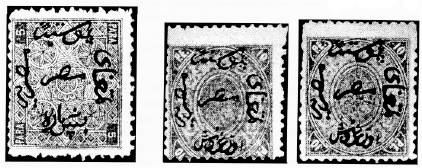
 Fig. 22 Numerals 20 joined and obscured in lower left corner. and as repaired. Errors and Major Plate Varieties The most outstanding error is the 5pi. with overprint (superscription) of the 10pi (Fig. 23). It occurs imperforate and perf. 12˝ x 15 but not perf. 12˝ (supposed examples have turned out to be forgeries). It also exists as a proof on unwatermarked paper. Other errors of overprint, including tęte-bęche overprints, have been reported in the past, but all have been shown to be forgeries. A used copy of the 10pi. has been reported printed on both sides13. I have not seen the actual stamp and the illustration is not clear, so I cannot say if it is genuine or a case of a forged overprint on printer's waste. Apart from the retouch already described, there exists on the 5pa. a major flaw in the overprint. The letter sad (the loop in the central word) is entirely missing in position 132 (Fig. 24). The 10pa. has a remarkable variety in position 56: a small but bold circle (corresponding to an Arabic numeral 5 or terminal letter heh) is in the upper right corner of the overprint (Fig. 25).
The 1pi. shows flaws in both the background design and the overprint. The background has breaks or indentations in the frame in several positions (Fig. 27). A flaw of quite a different type is the missing period between P and E, which may occur in one or both corners. These are not constant plate varieties, but are the result of accumulated ink filling in the small hole; they are not present on the proof sheets. The overprint also shows substantial breaks in some positions (Fig. 28). The 2pi. also has major breaks and missing parts in some positions of the overprint (Fig. 29). On the 5pi. there are no major breaks in the overprint, but position 77 shows a substantial scratch (a colorless line) through the top word (Fig. 30), probably the result of a creased transfer. The background also shows a prominent variety, distorted numeral 5 (Fig. 23), but it is a characteristic of transfer Type 5 and thus occurs twenty times in the sheet (positions 81 to 100). This variety therefore also occurs on the overprint error. I know of no major varieties of the 10pi. other than the retouch already mentioned. 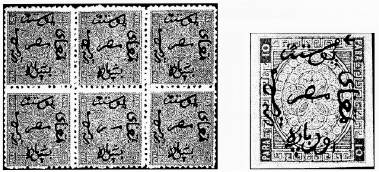 Fig. 24 Missing sad in center inscription. Fig. 25 
Fig. 26 Fig. 27 position 37 left pane position 98, right pane position 13, left pane  Fig. 28 position 69, left pane 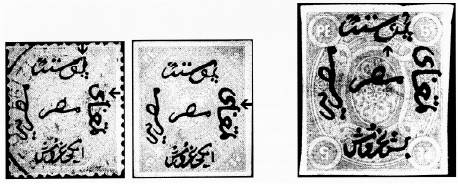
Although blocks of four (or larger) are known for all values, they are rare to very rare. Only one block, unused, is known of the 10pi., and of the 5pi., two unused blocks and a used block of twelve. At one time it was believed that unused blocks of both values were held in the Swedish Postal Museum, but they were later found to be proofs. Probably fewer than five blocks are known of the 2pi. and the 20pa. Curiously, the largest block of the 20pa., twelve, is imperforate; the largest block of the 2pi. appears to be a spectacular upper right sheet-corner block of six. Of the 1pi., several large blocks are known, the largest being an irregular block of 53, but even blocks of four are rare. An unused block of 21 of the 10pa. was in the Byam collection, but I know of no unused block of the 5pa. larger than six and a used block of eight. Used blocks are generally scarcer than unused, but one or more is known for each value up to the 5pi. Blocks of any sort with sheet margin are exceptional. Covers of the 1pi. are relatively common; it paid the single letter rate (up to 10 grams). The 5pa. was intended for periodicals mailed by the publisher. Used in that way, it was customarily affixed to the banner head of newspapers (Fig. 31). Examples are rare and I know of no more than four, all of which are cut down to various extents. The 5pa. is also known used in multiple or in conjunction with other stamps to pay the letter rate (eight copies were required); examples are rare.  Fig. 31 The 5pa. on newspaper. The 10pa., which was intended for non-periodical prints (including greeting cards), is very scarce used as a single on cover, and only slightly less scarce used in a strip or block of four to pay the letter rate. The 20pa. is a true rarity used alone as a single on cover, for the only rate for which it was suited was for very light letters sent from Cairo south (e.g., Assiut) carried by the State Courier Post (Chapter III) to places not yet served by the Viceroyal post. By contrast, pairs of the 20pa. used to pay the single letter rate are not unusual. A registered cover franked with six copies, paying the combined registration and postage, is known. The 2pi. paid for a double-weight letter internally, or a single letter from an internal office to an overseas one and vice versa. It was also used with a 1pi. stamp on single registered letters. In any form it is scarce but not rare. Of the 5pi., at least two covers exist on which a single is used to frank a heavy letter from Constantinople to Alexandria; a cover in the Byam collection is franked with a 5pi. plus a 2pi. to pay the postage to Upper Egypt (Luxor). A unique cover exists on which a block of twelve is used with other stamps on a heavy, insured letter. The 10pi. is known on but one cover, a heavy item addressed to Italy, with mixed franking with Italian stamps. Registered covers are far rarer than ordinary ones, as are insufficiently paid covers. On the latter one may find low values used improperly, such as a pair of the 10pa., which paid only half the letter rate, or a 20pa. used with a 1pi., half a plaster short of the required 2pi. for a double letter (Chapter XXIX). As noted in the notice of General Instructions quoted earlier, the stamps of the First Issue were not valid for prepaying postage on letters leaving Egypt, except for those destined for one of the three Egyptian consular post offices then in operation. Letters for foreign destinations therefore required foreign stamps as well as Egyptian ones. Covers with mixed franking therefore exist (Chapters VI, VII, VIII, IX, X). Examples with French, Italian, Austrian Levant, British, and Greek stamps are well known. Their rarity increases in the order cited. There has been no report of mixed franking involving the Russian post, but examples may exist. Cancellations For approximately the first four months of 1866 the retta (a diamond-shaped grid of 81 angular dots) was prescribed as the obliterator and a circular datestamp was struck alongside6c (Fig. 32). On this issue the retta is always black. By the middle of the year the retta was almost entirely abandoned and the datestamps were used as obliterators. These datestamps were all of Type I (Chapter XXVII). Only the larger towns in Lower Egypt had post offices and the list of datestamps known used on the First Issue is quite short: Alessandria, Atfe, Benha, Birket El Sab, Cairo, Damanhur, Damiata, Galiub, Kafer Zayat, Mansura, Michalla, Minet El Gam, Samanud, Suez, Tanta, Teh El Barud, Tookh, Zagazig, and Zifta & Mitg. However, official notices list a number of other offices to which stamps were to be sent. In addition, the consular offices in Constantinople, Smyrna, and Jiddah used Type I datestamps on this issue. Some additional post offices were opened as the period of the First Issue drew to a close; I know of only the cancellation of Desuk, which consisted of a double circle with an outlined crescent and star in the center, without a date (Fig. 33) (this type was also used exceptionally at Gedda).
Two anomalous types of cancellation must also be mentioned14: intaglio seals and a substitute retta. Two different seals are known on the First Issue, each inscribed in Arabic in negative, but unfortunately the name of the office is not legible on either. A single example of a circular grid of angular dots is known on a 1pi. stamp. It appears to be identical to the obliterator later used to cancel the stamps of the Suez Canal Co. at Suez (Chapter XXXV) and one can speculate that it may have been a substitute for the normal retta, made locally when the proper device may have been mislaid. As for colors14, the cancellations of most offices are found only in black. Blue came into use in Cairo in August 1866 and continued to be used until the end of the issue. Red has been seen used in Cairo from 1 July to 20 August 1866 and in Alexandria, where the only legible date I have seen is 30 June 1866. The red color does not appear to have had any special significance. Examples are obviously quite scarce. Bisects Supplies of 1pi. stamps in Alexandria and Cairo became alarmingly low in July 1867 shortly before the First Issue was scheduled to be replaced. To meet the emergency, a decree was issued authorizing an exception to the general prohibition of bisection: "In consequence of the lack of 1 piastre stamps, now current, permission has been given to the post-office at Alexandria to employ 2 piastres stamps, divided diagonally into two equal parts, for prepayment of letters, the two halves respectively representing the value of 1 piastre as from the 16th to the 31st instant. The cutting of the stamps is to be from the left upper corner to the lower right, as in the specimen affixed in the margin. The Director General. Muzzi Bey. Alexandria, 13th July, 1867." This permission was extended to Cairo almost immediately. Quite a few covers showing use of the bisect have survived and many more exist on piece. Forgeries are common, however. It is important to know that Alexandria always cancelled the bisects in black, whereas Cairo always used blue ink (Fig. 34). A very few imperforate 2pi. stamps were used in this way, and such bisects should not be rejected solely on account of the lack of perforation. At least one cover is known showing use of a bisect with a whole stamp to pay the 3pi. rate. Bisects used at Cairo are considerably easier to find than those used at Alexandria. 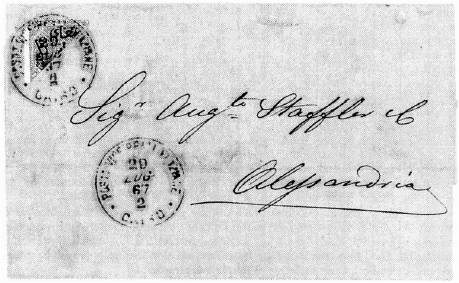 Fig. 34 Use of the bisected 2pi. The First Issue was withdrawn from sale after July 31st 1867, and the Second Issue replaced it on August 1st. The stamps remained valid for the month of August in order to allow patrons to use up any supplies they might hold. A consequence of this fact is that combination franking between the First and Second Issues was possible during August. The probability of such combination franking actually being used is obviously very low and I know of only one cover showing it (a 2pi. First Issue plus a 1pi. Second Issue, used at Gedda) Forgeries The First Issue has been extensively forged, but it is not feasible to describe each of the forgeries here (Fig. 35). Some are so crude as to be more like caricatures of the stamps, yet they are sometimes offered as genuine by dealers who do not know their business.
Some of the cruder ones have free-standing frame lines outside the designs. The first line of defense against forgeries is the watermark; most forgeries are unwatermarked. There is a more dangerous forgery that has a simulated watermark impressed into the paper, like that of the Second Issue stamps. I can recall seeing this type of forgery only of the 10pi. It is in a greenish slate shade that shows up easily when compared with the bluish slate of the genuine stamps. Furthermore, the "sun" has only eight rays, instead of the nine or ten of the genuine watermark.. Apart from the watermark, the surface of the paper of most forgeries is much smoother than the grainy paper of the originals (except the 1pi.). However, there are three types of forgery that pass these tests. With one of them specially manufactured watermarked paper was used and it is an extremely good match for the genuine. Although there are some small differences in the detail of the watermark, they are difficult to detect with certainty. The paper used was of smaller dimensions than the genuine; I was once able to examine a full sheet (of 50 subjects, I think it was) and there were no additional impressions of the watermark in the margins. The second type of dangerous forgery is known only of the 10pi. It was made from genuine printer's waste, on genuine watermarked paper, that had been delivered to Egypt along with the consignment of finished stamps. Thus only the overprint is forged; it was not well made and does not stand up to careful comparison with the genuine, especially the several transfer types of it. It was used to make fantastic varieties such as tęte-bęche overprints and overprint of 5 plasters on the 10pi. background. This forgery was produced imperforate, partly imperforate, and perf. 13. It is known with forged cancellation also. The other type of dangerous forgery is on genuine paper, obtained by a man named Salama (Fig. 36). As the story goes15,16 he at first approached the firm of Stanley Gibbons in 1891 to collaborate with him, but when his proposal was rejected he went ahead on his own. He ignored the 20pa. and 1pi. but forged all the other denominations, including the error 5pi. with 10pi. overprint. His productions were very well done and they continue to fool the most sophisticated collectors and dealers, even though they were first recognized in 1913. However, with the right information, Salama forgeries can be recognized with certainty. The simplest criterion to use is measurement of the width; the Salama forgeries that I have seen are too narrow17. The discrepancy is only about 0.3mm, but it is easily detected by comparison with a genuine stamp of any denomination. Another approach is to attempt to determine the lithographic transfer type of the background design and the overprint; the forgeries do not match any of them. There are some differences in shade, most noticeable with the 2pi. which is in a weak yellow without any of the orange component of the genuine. There are characteristic features, deviations from the genuine design, that allow these forgeries to be identified; they have been painstakingly described and illustrated by Chaftar15. Covers of the First Issue have been forged using genuine stamps; the bisected 2pi. has been the major target. Most of them have forged cancellations of Alexandria and are generally not well made. Comparison with Alexandria cancellations on ordinary, genuine stamps easily shows the difference, which is most pronounced in the date indicia. They have been described and illustrated by Boulad18. Another type of forgery makes use of genuine covers, usually originally franked with a single lpi. stamp, to which has been added another stamp, such as a 2pi., so placed as to seem to be tied by the normal informational strike of the date-stamp. The match of the date-stamp is usually not good and the date on the added stamp, when it can be read, is not likely to agree. Refrences:
|
|
|